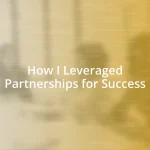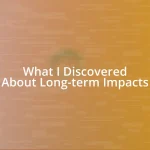Key takeaways:
- Understanding community diversity enriches personal growth by challenging biases and fostering empathy through conversations and shared experiences.
- Active listening, surveys, and collaborations with local organizations are essential methods for identifying community needs and promoting effective engagement.
- Sustaining long-term community involvement relies on building trust, consistency in engagement activities, and providing platforms for individuals to showcase their talents.

Understanding community diversity
Community diversity is a vibrant tapestry of cultures, languages, and perspectives that enriches our shared experiences. I’ve witnessed this firsthand in my own neighborhood, where Sunday afternoons come alive with the aroma of different cuisines wafting from every direction. It makes me wonder—how often do we truly take the time to explore the stories behind these flavors?
Understanding community diversity also involves recognizing the unique challenges each group faces. For instance, I once attended a local forum where immigrants shared their struggles with navigating social services. It struck me deeply how resilience plays a crucial role in their journey, and I found myself pondering—how can I be a better ally to those in this situation?
Feeling connected to diverse communities enhances our personal growth, helping us challenge our own biases and assumptions. I recall engaging in conversations with my neighbors about their traditions and beliefs—it opened my eyes to experiences I had never considered. Have you ever had a moment where a simple conversation shifted your perspective on someone else’s life? Those moments remind us that understanding is a two-way street filled with empathy and curiosity.

Identifying community needs
Identifying community needs starts with active listening. In my experience, joining local meetings and discussions opened my eyes to the genuine concerns of residents. I remember one evening at a neighborhood council meeting when a single mother shared her struggles with affordable childcare. Hearing her perspective was a pivotal moment that emphasized the importance of addressing such fundamental issues.
Additionally, utilizing surveys has proven effective in pinpointing the specific needs of diverse communities. I once helped design a questionnaire that focused not just on basic demographics, but also on the unique aspirations and challenges faced by different groups. The honest feedback we received revealed surprising insights, like the demand for more cultural activities and educational programs, which were often overlooked. This process reinforced my belief that community engagement must prioritize the voices of those involved.
Looking into collaborations with local organizations can also amplify our understanding of community needs. I collaborated with a nearby cultural center, where we hosted workshops addressing mental health in immigrant populations. The discussions that ensued were eye-opening, highlighting the stigma around mental health and the need for accessible resources. It struck me how interconnected these issues are, and how vital it is to create spaces for dialogue that foster understanding.
| Method | Effectiveness |
|---|---|
| Active Listening | Builds trust and reveals personal stories |
| Surveys | Provides data-driven insights for targeted initiatives |
| Collaborations with Organizations | Expands reach and fosters community engagement |

Building relationships with local leaders
Building relationships with local leaders is pivotal in fostering a strong sense of community. I remember the first time I reached out to a local council member. It felt a bit intimidating, but those initial conversations opened doors I never knew existed. Sharing my interests and asking about their initiatives helped us find common ground. From that point on, I made it a habit to check in regularly, which not only strengthened our rapport but also cultivated a mutual respect.
Engaging with local leaders means understanding their vision and challenges. It’s about being genuinely invested in their goals and how they intersect with community needs. I’ve learned that small gestures make a big impact, such as attending town hall meetings or volunteering at community events where leaders are present. When you show up and express your interest, you demonstrate your commitment to the community. Here are some effective ways to build those vital relationships:
- Attend local meetings to understand the priorities of leaders firsthand.
- Volunteer to support their initiatives, demonstrating your commitment.
- Schedule informal coffee chats to discuss mutual interests and ideas.
- Share your own community experiences to create a dialogue that resonates.
- Follow up with leaders on projects they’re passionate about to stay connected.
These simple actions have helped me feel more integrated within my community and have provided invaluable insights from local leaders, making collaboration more effective.

Creating inclusive engagement strategies
Creating inclusive engagement strategies requires a deep understanding of the diverse communities involved. I recall a project where we organized community forums, intentionally scheduling them at different times to accommodate various work schedules. It was rewarding to see parents, retirees, and night-shift workers share their thoughts. Isn’t it enlightening how such simple adjustments can bring forth diverse voices that might otherwise be missed?
Another effective strategy is to leverage technology for broader reach. I once facilitated a virtual town hall that allowed participants from different neighborhoods to join without the constraints of travel. The discussions were vibrant and diverse; it reminded me just how important it is to meet people where they are—literally and figuratively. Have you ever noticed how online platforms break down barriers and foster participation in ways that traditional meetings sometimes can’t?
Additionally, creating engagement strategies needs to lean into the strengths of the community. I partnered with local artists to host a mural project that not only beautified the neighborhood but allowed residents to express their cultural identities. Seeing community members transform their ideas into art was profoundly moving. It made me realize that when we involve the community directly, we create more than just programs; we build connections that resonate on a personal level.

Implementing effective outreach methods
Effective outreach methods are essential in engaging diverse communities meaningfully. Sometimes, I’ve found that just stepping outside of my comfort zone can lead to incredible outcomes. For instance, I once organized a potluck dinner, inviting neighbors from various backgrounds to bring their favorite dishes. I remember the warmth and laughter as we shared stories and food; it was a simple idea but transformed into a memorable evening that broke down barriers and sparked new friendships.
Another outreach approach I’ve embraced is utilizing local social media groups. When I first joined such a group, I was amazed at how quickly information spread and how engaged people from different backgrounds could be. A quick post asking for input about community events garnered a flood of responses, which not only highlighted the interests of different community members but also allowed me to tailor future activities to their needs. Have you ever considered how a local Facebook group could serve as a vibrant marketplace of ideas?
Moreover, incorporating feedback loops into outreach is invaluable. For example, after organizing an event, I would send out a quick survey to gather thoughts on what people enjoyed and what could be improved. This practice not only shows that you value their input, but it also fosters a sense of ownership among community members. I remember one participant sharing how a small tweak made all the difference for them. It was a heartening reminder that even minor adjustments could lead to greater involvement and satisfaction. Engaging with communities isn’t just about informing them; it’s about truly listening and evolving together.

Evaluating engagement outcomes
Evaluating engagement outcomes is crucial to understanding what truly resonates with diverse communities. After one initiative, I gathered community members to discuss their experiences. It was enlightening to witness firsthand how each perspective painted a unique picture of success—and sometimes, what we thought was a hit didn’t land the way we imagined.
I also learned that measuring outcomes isn’t just about numbers or attendance—it’s about the stories behind those metrics. I once spoke with a participant who said that just by being heard, they felt empowered to take action in their local neighborhood. It made me ponder: how many untold stories lie behind our engagement efforts? Recognizing these narratives can often reveal deeper insights into the effectiveness of our strategies.
Furthermore, my analysis included not just immediate feedback but also long-term impacts. After months of hosting various activities, I noticed some participants began initiating their own community gatherings, a sign of lasting engagement. Have you ever found joy in seeing something you started evolve independently? It’s a validating reminder that true engagement fosters a sense of community ownership, transforming initial participants into passionate advocates for connection.

Sustaining long-term community involvement
Sustaining long-term community involvement often hinges on building trust and relationships over time. I recall a series of gardening workshops I led in my neighborhood. Initially, participation was modest, but as attendees got to know one another, their investment in the project deepened. By the end of the season, many were communicating daily about plant care, sharing tips, and even swapping produce. It warmed my heart to see these casual acquaintances evolve into a supportive community that thrived not just on the garden but on their growing friendships.
One integral aspect I’ve observed is the importance of consistency in engagement activities. For example, I committed to a monthly book club that included titles from various cultures and perspectives. The first few sessions generated excitement, but it was the rhythm of regular meetings that transformed a group of strangers into a close-knit circle. After a few months, we began to share personal stories that related to the books, igniting vibrant conversations and enabling profound connections. Have you ever experienced how routine can foster a sense of belonging?
Moreover, developing platforms for community members to showcase their talents can significantly enhance involvement. I once organized an open mic night where locals of all ages could share poetry, music, or storytelling. The nervous laughter as a shy teenager took the stage turned into uproarious applause and cheers as they found their voice. Witnessing this transformation reminded me that when individuals feel valued and celebrated, they are more likely to contribute their passion and energy to the community. Isn’t it incredible how uplifting creativity can create lasting bonds?















